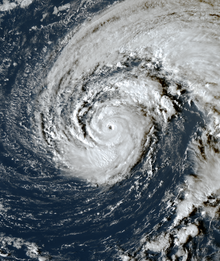 Epsilon nearing peak intensity, late on October 21 | |
| Meteorological history | |
|---|---|
| Formed | October 19, 2020 |
| Dissipated | October 26, 2020 |
| Category 3 major hurricane | |
| 1-minute sustained (SSHWS/NWS) | |
| Highest winds | 115 mph (185 km/h) |
| Lowest pressure | 952 mbar (hPa); 28.11 inHg |
| Overall effects | |
| Fatalities | 1 direct |
| Damage | Minimal |
| Areas affected | |
| IBTrACS | |
Part of the 2020 Atlantic hurricane season | |
Hurricane Epsilon was a strong tropical cyclone that affected Bermuda, and parts of North America and Western Europe. The twenty-seventh tropical or subtropical cyclone, twenty-sixth named storm, eleventh hurricane, and fourth major hurricane of the extremely-active 2020 Atlantic hurricane season,[nb 1] Epsilon had a non-tropical origin, developing from an upper-level low off the East Coast of the United States on October 13. The low gradually organized, becoming Tropical Depression Twenty-Seven on October 19, and six hours later, Tropical Storm Epsilon. The storm executed a counterclockwise loop before turning westward, while strengthening. On October 20, Epsilon began undergoing rapid intensification, becoming a Category 1 hurricane on the next day, before peaking as a Category 3 major hurricane on October 22, with maximum 1-minute sustained winds of 115 mph (185 km/h)[nb 2] and a minimum central pressure of 952 millibars (28.1 inHg). This made Epsilon the easternmost major hurricane this late in the calendar year, as well as the strongest late-season major hurricane in the northeastern Atlantic, and the fastest recorded case of a tropical cyclone undergoing rapid intensification that far northeast that late in the hurricane season.[2] Afterward, Epsilon began to weaken as the system turned northward, with the storm dropping to Category 1 intensity late that day. Epsilon maintained its intensity as it moved northward, passing to the east of Bermuda. On October 24, Epsilon turned northeastward and gradually accelerated, before weakening into a tropical storm on the next day. On October 26, Epsilon transitioned into an extratropical cyclone, before being absorbed by another larger extratropical storm later that same day.
Epsilon brought tropical storm conditions to Bermuda while passing to the east of the island. The storm brought large surf to parts of the Caribbean and the East Coast of the United States. Epsilon's remnants later brought severe weather to the British Isles. The storm's remnants also produced one of the largest October swells on record in Nazaré, along the Atlantic coast of Portugal.[3] Epsilon caused one death in Florida, when a 27-year-old man drowned in rip currents produced by the hurricane. Overall damage from the storm was minor.
- ^ "Saffir-Simpson Hurricane Wind Scale". National Hurricane Center. Archived from the original on June 20, 2020. Retrieved June 22, 2020.
- ^ Cite error: The named reference
shatters recordswas invoked but never defined (see the help page). - ^ Cite error: The named reference
huge swellwas invoked but never defined (see the help page).
Cite error: There are <ref group=nb> tags on this page, but the references will not show without a {{reflist|group=nb}} template (see the help page).
© MMXXIII Rich X Search. We shall prevail. All rights reserved. Rich X Search
